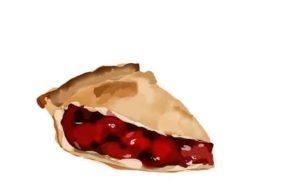Two related questions posted on the blog recently:
Q. I’ve been reading that lard is now considered a good fat, as long as it’s not hydrogenated. I realize that lard is still saturated fat, so it’s not ‘good’ like olive oil. And like all fats, it must be eaten in moderation. But I’m wondering what you think about going back to Gramma’s pie crust recipe. Crisco/butter just never did make the same good crust …
Crust-y Curious
Q. Like Crusty Curious, I’ve also been wondering about lard and pie crusts, as well as other saturated fats. If we limit our intake of saturated fats to recommended amounts, does it matter what TYPE of saturated fat we use? Are palm oil, coconut oil, butter, lard, and beef drippings (for homemade gravy) all equivalent, nutritionally? Or is there some good reason to avoid certain of these?
Judy
A. Pie crusts are a matter near and dear to my heart and I’ve been collecting pie crust recipes for years. My current favorite uses a mixture of butter (for flavor) and lard (for flakiness). But you will find equally ardent advocates for all-butter crusts and even some die-hard shortening devotees.
Epicurious.com’s Food Editor Sarah Kagen has long been a fan of this recipe, which uses part butter and part shortening. “But lately,” she says, “I’ve had several crusts made with part butter and part lard, and I have to say, I think I’ve been converted. The lard creates flakiness like shortening, but it adds a wonderful golden toastiness.”
Epicurious.com’s Associate Editor Lauren Salkeld (who is a graduate of the French Culinary Institute’s Classic Pastry Arts Program) says, “We made all butter dough in school, so that’s what I’m used to. I find it flaky and I prefer the flavor.”
Aside from the culinary debate, is there any difference nutritionally between butter, lard, and the naturally saturated fats found in palm kernel and coconut oil (used to make trans-fat free shortening)?
Here are a few facts that might surprise you :
1. Butter contains about 20% less fat and calories per ounce than lard or saturated vegetable fat, because it contains some water. (When substituting butter for other fats, adjust quantities accordingly.)
2. All of these products contain a mixure of saturated, monounsaturated, and polyunsaturated fats. Lard actually contains the least amount of saturated fat (11g per ounce) while coconut oil contains the most (24g per ounce).
3. Animal fats (lard and butter) contain more monounsaturated fat than palm kernel and coconut oil. In fact, lard contains more monounsaturated fats (13mg per ounce) than saturated fats (11g per ounce).
4. Butter contains twice as much cholesterol (60mg per ounce) as lard (27mg per ounce). Vegetable shortenings contain no cholesterol.
5. Lard contains 280mg of omega-3 fatty acids per ounce; butter has 88mg per ounce. (Palm kernel and coconut oil contain little or no omega-3s).
6. Butter contains a fair amount of vitamin A (700mg per ounce) whereas palm kernel oil contains a good helping of vitamin K (7mcg per ounce).
7. Both palm kernel and coconut oils contain natural phytosterols, which can help to reduce cholesterol levels by blocking the cellular uptake of cholesterol.
Regardless of what form of fat you’re trying to build a case for, you can find some support for it here. And of course there’s the argument that saturated fat isn’t really bad for you, anyway; it’s the carbs you eat with it that do the damage. (More comforting for bacon eaters than pie lovers.)
The only fat I can advise you to avoid completely are shortenings made with partially hydrogenated vegetable oil (old-style Crisco) or a mixture of fully hydrogenated and unhydrogenated vegetable oils (new-style Crisco). The former is full of trans fats and the latter, although it claims to be nearly trans fat free, is full of “interesterified fats,” which appear to be no better for you. (Also take care to select lard that has not been hydrogenated.)
No matter what form of fat you use, of course, pie crust is not a low-fat item. One slice of a double-crust pie will use up about a quarter of your daily allowance of fat and around 80% of your allowance for saturated fat (not counting the filling).
So, in answer to the questions above, as long as your overal intake of fat, calories, and saturated fat is not excessive, and you are avoiding all hydrogenated products, use whatever you like to make your pie crust. (And send me your recipe!)

All those initials after her name does not appear to have improved her knowledge of good nutrition…